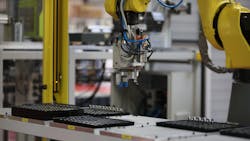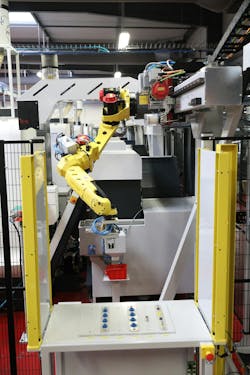How Digitalization in Aerospace Manufacturing Offers Real Benefits to the Supply Chain
Key Highlights
- Industry 4.0 technologies such as AI and robotics are enhancing production optimization, disruption prediction and supply chain transparency in aerospace manufacturing.
- Centralized data systems enable better analytics, leading to reduced waste, improved energy efficiency and support for sustainable development goals.
- Digitalization helps mitigate skilled labor shortages by training personnel in specialized areas like robotics maintenance and process optimization, fostering upskilling and employee retention.
Companies in the aerospace industry’s manufacturing and supply chain are increasingly seeing the quantifiable advantages that stem from the digitalization of production operations.
In this article, Director of Eastern European Operations at JPB Système Katarzyna Kalisz discusses where and how Industry 4.0 technologies like artificial intelligence (AI) and industrial robotics are shifting the dial, including when it comes to complementing the human workforce.
What technologies can enhance manufacturing and supply chain in the aerospace sector?
Deloitte’s 2025 Aerospace and Defense Industry Outlook highlights the potential for broad-based operationalization of many technologies, including AI, within today’s aerospace industry. By embracing this move towards digitalization, companies can unlock a path to creating resilience and securing long-term competitiveness, aside from boosting efficiency.
AI and advanced data systems enable companies to complete tasks like:
- Optimizing production
- Predicting and preparing for disruptions
- Ensuring full traceability of parts
- Strengthening supply chain reliability
Digital tools also support continuous innovation, ensuring companies are more responsive to changing customer needs while gradually introducing smarter, safer and more sustainable solutions.
Why digitalization improves data access and analysis
Disparity in data collection still exists across the aerospace industry, with many companies not having access to their data at all. When the data is not centralized and archived to provide the retrospective insight needed, then using AI effectively becomes impossible.
Those already equipped to leverage precise data analytics are empowering themselves with the ability to:
- Advance production planning
- Improve material efficiency
- Reduce waste
- Optimize energy consumption
For JPB Système, this means improved operational efficiency as well as a tangible contribution to sustainable development and decarbonization efforts. Rather than only focusing on productivity, digitalization is also about responsibility, ensuring that the aerospace industry evolves in line with environmental goals.
Katarzyna asserts that digitalization is not limited to the factory floor but extendable to the wider industrial ecosystem. The sharing of secure data between manufacturers, suppliers, MROs and customers allows for greater transparency and trust across the supply chain.
This helps to facilitate effective collaboration with partners, while enabling earlier risk anticipation and the creation of more resilient production systems. In an industry where delays or disruptions can have significant consequences, this level of integration can make all the difference.
How to integrate digital tools with the human workforce
In order to fully realize its true potential, digitalization must integrate with the human workforce effectively. This industry is built on precision, expertise and trust, which is why employees need to feel confident and supported when using new tools and AI applications for aerospace.
The right application of technology can bring this to fruition. Companies that automate repetitive or low-value tasks can free up employees to focus on higher-impact roles, upskilling opportunities in areas where human judgment is irreplaceable.
This showcases how digitalization isn’t just about becoming more efficient, it can function as a catalyst for growth, empowering individuals to make a greater contribution while creating a more inspired, fulfilled, resilient and capable workforce.
Upskilling a company’s workforce into higher-value roles and potentially more fulfilling career paths may even help support employee retention.
How embracing digitalization helps mitigate skilled labor shortages
The digitalization of certain manufacturing processes can also address the skilled labor shortages currently rampant in the industry, because these employees can be trained to acquire the specialized skills that are in shortest supply on the market.
For example, at JPB Système, personnel who were previously undertaking assembly-based roles could be trained in functions like specialist welding activities. This process is already in line with the company’s history of investing in training, reskilling and engagement alongside technology itself.
Katarzyna notes that digitalization could create demand for new expertise in areas such as:
- Data analysis
- Robotics maintenance
- Process optimization
By blending technology and human development, companies can bolster competitiveness and the ability to attract talent in a challenging labor market.
For potential employees, the opportunity to work within a state-of-the-art environment enabled with Industry 4.0 technology could be seen as a great benefit. This is because employers that continually equip themselves with new technologies to realize smart manufacturing can offer a modern, efficient working environment that draws new talent.
Those forward-looking companies that are embracing digitalization give themselves a competitive edge when it comes to hiring, thereby increasing capacity and productivity.
At JPB Système, the team typically adds new employees every time they install a new robot. To Katarzyna, this showcases proof that humans need robots and robots need humans.
About the Author

Katarzyna Kalisz
Katarzyna Kalisz is Director of Eastern European Operations at JPB Système, a leading manufacturer of efficiency-enhancing technology solutions for aerospace, aeronautics and other industries.


